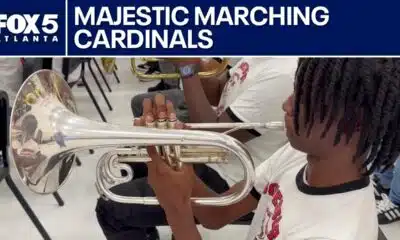News from the South - Louisiana News Feed
What Trump’s education shakeup could mean for a Louisiana school Sen. Bill Cassidy’s wife started • Louisiana Illuminator
What Trump’s education shakeup could mean for a Louisiana school Sen. Bill Cassidy’s wife started
by Marina Villanueve, Hechinger Report, Louisiana Illuminator
February 10, 2025
Alcide Simmons said he has only one word to describe what it was like for his daughter, Brooke, as she struggled to spell and read: “torture.”
“‘Spell ‘duck,’ Brooke,” Simmons recalled. “And it would be, ‘P, C, K, something,’ no matter how many times.”
His wife, Leslie Johnson-Simmons, said she saw her creative, smart and chatty daughter retreat into herself as she tried to learn to spell like other first graders in her class at a private school in Louisiana.
“She began to clam up, and that wasn’t my child,” Johnson-Simmons said.
Screening revealed that Brooke had dyslexia — a common learning disability stemming from neurological differences that make it difficult to identify sounds and associate them with letters and words. When her private school told the Simmons family they would have to shell out up to $10,000 a year for once-a-week personalized reading instruction and other services, they decided to transfer their daughter to Louisiana Key Academy.
Now, Brooke, a fifth grader, is thriving at the charter school, her parents say, and each day receives 90 minutes of specialized reading instruction alongside a small group of other students.
GET THE MORNING HEADLINES.
The school, which serves more than 700 students on three campuses in the state, was co-founded in 2013 by Laura Cassidy, a retired breast cancer surgeon whose husband is Republican U.S. Sen. Bill Cassidy — the new chair of the Senate committee whose role includes overseeing education. The Cassidys have a daughter with dyslexia and have long advocated for similar students and their families.
Nationwide, about 15% of students, or 7.5 million children, receive special education services. Most attend traditional public schools, but a growing number are enrolling at specialized charter schools like Louisiana Key Academy. The federal government plays a role in serving those students by issuing guidance, defending their right to a “free appropriate public education” and providing money. Louisiana Key Academy, for example, received $165,000 in special education funds in 2023, the most recent year for which data was available; including pandemic relief and school lunch money, federal funds made up 18% of the $11.6 million in revenue it reported that year.
President Donald Trump has vowed to shrink the federal government’s role in education. Already in his first weeks in office, he’s sent the education world into a tailspin by trying to impose a temporary freeze on federal grants and loans and signing an order to expand school choice, among other actions. He is also reportedly preparing an executive order to dismantle the Department of Education, with the ultimate goal of eliminating it altogether. Families and advocates are watching to see how the new administration’s approach will alter the day-to-day reality for students who rely on special education services.
Laura Cassidy said in a December phone interview that she doesn’t believe Congress will make sweeping cuts to federal special education funding.
“I don’t think that’s going to go away,” said Cassidy, but if it does, she hopes the state will make up the difference. Of the funding freeze, she wrote in an email, “Any disruption in funding would be a problem. But our state superintendent assures us all is OK.”
Cassidy said federal funds provide critical support to the school. But she added that she prefers state oversight over education and allowing parents to exercise school choice.
“I think it’s easier if most of the control is in the state,” Cassidy said.
Sen. Bill Cassidy, in an interview with The Hechinger Report, said he was hopeful about Trump’s approach to education, given the nation’s dismal reading scores.
“One of President Trump’s great gifts is that that guy will break an egg and he will look at things differently,” Cassidy said. “And so I think we need to kind of bring new, fresh eyes to this problem, and to say, ‘Sure, it’s status quo, but is status quo always the way to be if status quo is giving you failure, failure, failure?’”
Laura Cassidy said she and her husband’s experience advocating for their daughter fueled her passion for ensuring that students with a learning disability can access the instruction and support they need — no matter their family’s income.
“It can be very devastating for a family and a student to not be identified and get the education that they need, and it really impacts their whole life,” she said.
Cassidy said she and other parents who launched the school decided a public charter school would give them the flexibility and funding to provide that access. Unlike private schools, charter schools don’t charge tuition, but like private schools, they are exempt from some local and state laws — including rules concerning union contracts and teacher certification — that traditional public schools must abide by.
Lisa Card, lower school principal of Key Academy’s Baton Rouge campus, said parents come to the school exasperated, feeling like they’ve fought for years to help their children learn a fundamental skill.
“They’re in tears,” she said. “They’re angry.”
Most states, including Louisiana, now provide universal screening in early grades for dyslexia, but older students don’t typically qualify, according to Harvard Graduate School of Education professor Nadine Gaab. Parents and special education advocates say it remains complicated and costly to obtain a diagnosis and get needed support for children of any age. Louisiana Key Academy provides screenings and evaluations for free, through the Baton Rouge-based Dyslexia Resource Center.
On a typically balmy December afternoon, a dozen students in teacher Olivia LeDuff’s fourth-grade structured language arts class at Louisiana Key Academy discussed the book “Hatchet,” which tells the story of a young boy surviving in the wilderness after a plane accident leaves him stranded.
LeDuff said “Hatchet” is above the students’ reading level — but that she played them an audio recording of the book to help work on their vocabulary. She said the bulk of the class is spent on what’s called phonological awareness: working with and manipulating
words and sounds.
“We play lots of word games,” she said. “We do rhyming. We do adding and deleting phonemes. We teach them that a phoneme is a single speech sound so they know how to break it up.” For example, the word “cat” is broken down as “cuh-at.”
A large body of research, known as the science of reading, stresses that all students need instruction in phonics and other reading skills. A 2022 series by APM Reports found that for decades, schools have relied instead on curricula urging students to learn to read by relying on clues like context.
At Louisiana Key Academy, teachers approach nearly every subject with the needs of students with dyslexia in mind. That could mean, for example, a science instructor providing additional help with scientific vocabulary or a math teacher breaking down word problems. Nationwide, researchers are calling for teachers to embed reading instruction into content classes.
Of 80 teachers at Key Academy campuses, Laura Cassidy said 14 have undergone two-year intensive training to become certificated academic language therapists and two have completed one year of training. Another 28 are in training or waiting to take the exam. Three dozen other teachers have taken an online course on dyslexia and are receiving other professional development, according to Cassidy.
Cassidy says small class sizes, of roughly a dozen students per teacher at the Baton Rouge campus, allow teachers to provide more one-on-one help. The school spends $18,476 per student per year, according to the state’s report card, compared to a state average of $15,393.
“It’s an expensive model,” Cassidy said. “So obviously any funding we get, including that from special ed, is very important.”
Critics of school choice have long argued that charter schools divert public money from local school districts while spending more taxpayer dollars per student.
Cassidy praised Louisiana’s pro-school choice policies and embrace of specialized schools.
“I’m hoping that’s where education goes, where it’s really tailored specifically to the needs” of students, she said. In a Jan. 30 email, she wrote that she was not yet familiar with the details of Trump’s executive order expanding school choice released the previous day.
Louisiana Key Academy is one of 176 specialized charter schools in 23 states that focus on students with disabilities, according to an October report by the Center for Learner
Equity that relied on 2020-21 data, and the number of students with disabilities served by these schools has more than doubled since 2012.
With specialized charter schools on the rise, some researchers and groups, including the National Council on Disability and the Center for Learning Equity, have questioned whether they conflict with decades of law and precedent upholding the right of children with disabilities to learn in a general classroom alongside peers without disabilities when possible.
Under the 50-year-old law now known as the Individuals with Disabilities Education Act, or IDEA, students with disabilities should be educated in a general classroom “to the maximum extent appropriate.”
There is an exception under the law, for “when the nature or severity of the disability of a child is such that education in regular classes with the use of supplementary aids and services cannot be achieved satisfactorily.”
Research has found that inclusion in the classroom benefits students’ personal and social development.
“Inclusion matters, full stop,” said Jennifer Coco, senior director of strategy and impact at the Center for Learner Equity. “On a human level, we prioritize learning environments that include all types of kids, because it doesn’t feel good to be excluded.”
Some special education advocates also point out that a student’s needs can change over time and that segregating them in a specialized charter devoted to their disability might keep them from progressing or learning alongside their peers when they are ready.
Under federal law, there are no hard and fast rules around how long a student can stay in a separate setting.
In a 2018 report to the White House, the National Council on Disability said that specialized charter schools are not “automatically appropriate for all students with the same disability.” The report stressed: “While charter schools focusing specifically on students with disabilities offer a valuable opportunity for some students, these schools run counter to the legal presumption in favor of education in the general education classroom.”
The council urged parents and school personnel to regularly assess whether students at specialized charter schools still need to attend such a school.
Cassidy said she’s aware of such concerns — and that the school is focused on evaluating students to see whether their reading skills have improved enough to return to a general classroom.
She said that returning to a general education classroom is easier for students who enroll and get help earlier. A student in first grade, for example, may be ready to leave the school by fourth grade if they show progress in reading fluency. But “very few” students at Louisiana Key Academy enter in first grade, she said, with the majority arriving when they’re older and thus needing more prolonged help.
By some conventional measures, Louisiana Key Academy is not performing well: Its Baton Rouge campus scored an F for student performance on the Louisiana Department of Education’s report card system in the 2022-23 school year. Its 43.4 performance score was a slight improvement over the year prior, when it received a 39.8. The score looks at how students are mastering content for their grade level.
The report card says “urgent intervention is required” for students of color and economically disadvantaged students, who performed far worse than students at the vast majority of schools in Louisiana. Overall, about 70 percent of students at the campus are identified as African American, and nearly three-quarters as economically disadvantaged.
Still, the school has a B rating for student progress.
Cassidy said the student progress rating shows the school is making a difference. She said the low scores on student performance reflect how behind students are when they arrive at the school.
“We’re getting kids in the third and fourth grade when we would like them in the first grade,” Cassidy said. She added that schools like Louisiana Key Academy serve a crucial role in a system that’s failing some children right now. “We’re truly changing lives,” she said. “It’s just slower than I would like.”
Trump appears determined to shake up the education system. Like other Republicans before him, including former President Ronald Reagan and former Speaker of the House Newt Gingrich, he has called for the closure of the Department of Education, whose agencies include the Office of Special Education and Rehabilitative Services.
The department also funds more than 50 technical assistance centers that help states and districts serve students with disabilities and provides grants to state education departments, universities and nonprofits for topics ranging from parent training to teacher professional development.
The conservative policy blueprint Project 2025, some of whose architects have joined the Trump administration, urges lawmakers to send federal special education funding directly to school districts in the form of “no-strings attached” block grants, instead of to states first. Project 2025’s authors also want lawmakers to move oversight over whether states are complying with special education law, including ensuring schools follow a child’s Individualized Education Program, to the U.S. Department of Health and Human Services.
Trump’s January announcement freezing federal grants and loans (an order rescinded the next day after an outcry) was also outlined in Project 2025, as was his call to cut the Department of Education.
Sen. Cassidy, who took over the Senate Health, Education, Labor and Pensions Committee this year, told The Hechinger Report that he doesn’t believe Congress has enough votes to abolish the Department of Education.
“I don’t think a single Democrat would vote for it,” he said.
Still, Cassidy said he wants to look at other potential reforms.
Project 2025 proposes folding the Department of Education’s Office of Civil Rights into the Department of Justice — a move that critics say would jeopardize federal oversight over discrimination.
Cassidy noted that the DOJ prosecutes Medicaid and Medicare fraud with the cooperation of the Department of Health and Human Services. “We have to look at it,” he said of the Project 2025 proposal. But he added, “there’s a lot of precedent for this in other agencies.”
He has also spoken in support of Project 2025’s push to reform how schools like Louisiana Key Academy get their special education funding by providing them direct, no-strings attached block grants. “My gosh, if you could block grant those dollars to the state for the primary and secondary education and give them more freedom to do what they’re supposed to do, that would be a good thing,” Cassidy told the television station KSLA.
The federal government already doles out money in block grants for other spending categories, but critics have long noted that previous block grants have resulted in less funding for affected programs. For example, a sweeping 1981 bill consolidating 75 programs into nine new block grants ended up reducing overall funding by 12%, or $1 billion, according to a 2022 report by the Congressional Research Service.
It’s unclear what exactly a no-strings block grant would mean for schools, according to Tammy Kolbe, principal researcher of education systems and policy at the nonprofit American Institutes for Research. Kolbe has researched how the existing formula already doles out fewer special education dollars per child to states with the largest populations of children ages 3-21.
And advocates for special education, including Katy Neas, CEO of advocacy group The Arc of the United States, say they’re concerned that a no-strings attached block grant would weaken protections for students with disabilities.
“That’s a concern because we know that states and districts in too many places are struggling right now to meet their obligations to these students,” said Neas, whose nonprofit serves people with intellectual and developmental disabilities. “And what we need is more intense focus on helping schools do the job that they want and need to do. And I don’t see how taking away the specific sort of guardrails of the federal law will help them do that.”
Need to get in touch?
Have a news tip?
Back at Louisiana Key Academy on an afternoon before Christmas break, Brooke Simmons grinned as she talked about an upcoming field trip to a science museum and Secret Santa with her classmates. “I have a lot of friends, and I like talking to them a lot,” she said.
Dressed in a uniform paired with a pink bow and glimmering necklace, Brooke said she appreciates the small breaks and lighthearted approach the school provides for quizzes, tests and exams.
“At this school, they give us motivation,” Brooke said. “They’ll probably, like, throw in a little joke in the middle of it.”
Her parents say they’re overjoyed by her renewed confidence and proud of her love of reading and art.
Alcide Simmons said he doesn’t understand calls to shutter the Department of Education.
“We need that oversight,” he said. “Absolutely.”
YOU MAKE OUR WORK POSSIBLE.
Contact reporter Marina Villeneuve at 212-678-3430 or villeneuve@hechingerreport.org
This report was produced by The Hechinger Report, a nonprofit, independent news organization focused on inequality and innovation in education. Sign up for the Hechinger newsletter.
Louisiana Illuminator is part of States Newsroom, a nonprofit news network supported by grants and a coalition of donors as a 501c(3) public charity. Louisiana Illuminator maintains editorial independence. Contact Editor Greg LaRose for questions: info@lailluminator.com.
News from the South - Louisiana News Feed
Saturday 10 PM Tropics Update: One far-off tropical wave to watch
SUMMARY: A tropical wave near Africa is emerging over the Atlantic but remains disorganized. The National Hurricane Center gives it a 60% chance to develop into a depression or tropical storm, possibly becoming Gabrielle. This system may move northward, staying over the open Atlantic and away from the Gulf, posing no immediate threat. Since the last named storm in late August, stable air, dry conditions, and increased wind shear have suppressed tropical activity in the Atlantic. The next storm names are Gabrielle, Humberto, and Imelda, with only the current wave showing potential for development at this time.
Meteorologist Alexandra Cranford tracks a lone disturbance with a chance of development on Saturday night, September 13, 2025.
News from the South - Louisiana News Feed
Haynes wanted in on Wildlife bribery scheme too, informant says
SUMMARY: Dusty Guidry, a former consultant who pleaded guilty to accepting $800,000 in bribes, testified that Assistant District Attorney Gary Haynes sought involvement in a bribery scheme at the Louisiana Department of Wildlife & Fisheries. Haynes, on trial for conspiracy, bribery, money laundering, and obstruction, was previously appointed to run Lafayette’s pretrial diversion program after supporting DA Don Landry. Guidry revealed Haynes pressured him to include him in a similar diversion program scheme at Wildlife & Fisheries, receiving checks totaling $90,000. The scheme involved splitting bribes among Guidry, vendor Leonard Franques, and former department secretary Jack Montoucet, who has also been charged. The statewide program never launched.
Read the full article
The post Haynes wanted in on Wildlife bribery scheme too, informant says appeared first on thecurrentla.com
News from the South - Louisiana News Feed
OPPJ Comprehensive Plan
SUMMARY: The Ouachita Parish Police Jury is conducting a series of community meetings to gather public input for their comprehensive plan guiding future growth. Police Jury members, including Larry Bratton from District D, emphasize the importance of reflecting residents’ voices in the master plan. Community members participated in interactive stations, allocating resources to priorities like infrastructure and downtown development, to help shape goals for the next 2, 5, and 20 years. Landscape architect Matt Pizatella and partners from Atlas support the effort. Bratton stresses that without proactive planning, the parish risks costly and less beneficial outcomes in the long term.
OPPJ Comprehensive Plan
-
News from the South - North Carolina News Feed5 days ago
What we know about Charlie Kirk shooting suspect, how he was caught
-
Local News7 days ago
US stocks inch to more records as inflation slows and Oracle soars
-
Local News6 days ago
Russian drone incursion in Poland prompts NATO leaders to take stock of bigger threats
-
News from the South - North Carolina News Feed6 days ago
Federal hate crime charge sought in Charlotte stabbing | North Carolina
-
Local News Video6 days ago
Introducing our WXXV Student Athlete of the Week, St. Patrick’s Parker Talley!
-
The Center Square6 days ago
Weapon recovered as manhunt continues in Kirk assassination investigation | National
-
News from the South - Arkansas News Feed5 days ago
NW Arkansas Championship expected to bring money to Rogers
-
Our Mississippi Home4 days ago
Screech Owls – Small but Cute














































